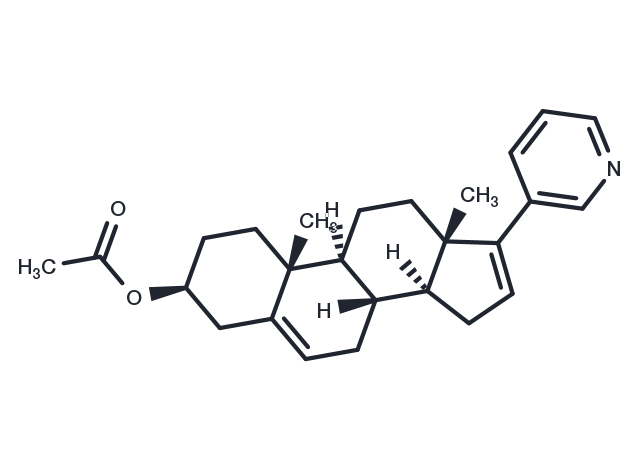Powder: -20°C for 3 years | In solvent: -80°C for 1 year


Abiraterone Acetate (CB7630) is an androstene derivative that inhibits STEROID 17-ALPHA-HYDROXYLASE and is used as an ANTINEOPLASTIC AGENT in the treatment of metastatic castration-resistant PROSTATE CANCER.

| Pack Size | Availability | Price/USD | Quantity |
|---|---|---|---|
| 5 mg | In stock | $ 30.00 | |
| 10 mg | In stock | $ 47.00 | |
| 50 mg | In stock | $ 59.00 | |
| 100 mg | In stock | $ 77.00 | |
| 500 mg | In stock | $ 189.00 | |
| 1 mL * 10 mM (in DMSO) | In stock | $ 52.00 |




| Description | Abiraterone Acetate (CB7630) is an androstene derivative that inhibits STEROID 17-ALPHA-HYDROXYLASE and is used as an ANTINEOPLASTIC AGENT in the treatment of metastatic castration-resistant PROSTATE CANCER. |
| Targets&IC50 | CYP17:72 nM |
| In vitro | In rodent models, intraperitoneal administration of Abiraterone rapidly undergoes deacetylation. Administered as its acetate prodrug (CB7630), it suppresses circulating testosterone to undetectable levels and significantly reduces the weight of androgen-sensitive organs. Abiraterone is well-tolerated, with an average elimination half-life of 27.6 hours, permitting once-daily dosing. Preclinical studies using Abiraterone demonstrate a reduction in CYP17 downstream androgen production, leading to a decrease in the weight of the mouse ventral prostate, testes, and seminal vesicles. |
| In vivo | Abiraterone inhibits the in vitro proliferation and androgen receptor (AR)-regulated gene expression of AR-positive prostate cancer cells, potentially due to its AR antagonistic effects beyond steroidogenesis inhibition. It blocks the enzyme 3β-hydroxysteroid dehydrogenase (3βHSD), essential for synthesizing bioactive androgens, thereby inhibiting DHT synthesis and androgen receptor responses. Abiraterone uniquely demonstrates a favorable complex formation with heme iron only in SM1. It inhibits CYP17A1, blocking androgen synthesis, and prevents the conversion of DHEA to Δ4-androstenedione and Δ5-androstenediol to testosterone. In rat testicular microsomes, abiraterone inhibits C17,20-lyase with an IC50 of 5.8 nM, significantly reducing testosterone secretion by 48% and correspondingly increasing LH concentration by 192%. |
| Kinase Assay | C17,20-lyase activity assay: Microsomes are diluted to a final protein concentration of 50 μg/mL in the reaction mixture which contains 0.25 M sucrose, 20 mM Tris-HCl (pH 7.4), 10 mM G6P and 1.2 IU/mL G6PDH. After equilibration at 37 °C for 10 minutes, the reaction is initiated by addition of βNADP to obtain a final concentration of 0.6 mM. Prior to the distribution of 600 μL of the reaction mixture in each tube, test compounds are evaporated to dryness under a stream of nitrogen and then are incubated at 37 °C for 10 minutes. After incubation with Abiraterone, 500 μL of the reaction mixture is transferred to tubes containing 1 μM of the enzyme substrate, 17OHP. After a further 10 minutes incubation, tubes are placed on ice and the reaction is stopped by addition of 0.1 ml NaOH 1N. Tubes are deep-frozen and stored at -20 °C until assayed for Δ4A levels. A Δ4A RIA is developed and automated on a microplate format in our laboratory using a specific antibody against Δ4A and instructions provided by Biogenesis. The separation of free and bound antigen is achieved with a dextran-coated charcoal suspension. After centrifugation, aliquots of the clear supernatant are counted in duplicates in a liquid scintillation counter. The Δ4A concentrations of unknown samples are determined from the standard curve. The detection limit is 0.5 ng/mL and the within and between assay coefficients of variation are 10.7 and 17.6%, respectively at an assay value of 13 ng/mL. The rate of enzymatic reaction is expressed as pmol of Δ4A formed per 10 minutes and per mg of protein. The value of maximum activity without inhibitor (control) is set at 100%. The IC50 values are calculated using non-linear analysis from the plot of enzyme activity (%) against log of inhibitor concentration. |
| Cell Research | LNCaP and VCaP cells are seeded in 96-well plates and grown in CSS-supplemented phenol red-free or FBS-supplemented media for 7 days. Cells are treated with Abiraterone at 24 hours and 96 hours after plating and cell viability is determined on day 7 by adding CellTiter Glo and measuring luminescence. (Only for Reference) |
| Synonyms | Zytiga, CB7630 |
| Molecular Weight | 391.55 |
| Formula | C26H33NO2 |
| CAS No. | 154229-18-2 |
Powder: -20°C for 3 years | In solvent: -80°C for 1 year
DMSO: 3.92 mg/mL (10 mM), Sonification is recommended
You can also refer to dose conversion for different animals. More
bottom
Please see Inhibitor Handling Instructions for more frequently ask questions. Topics include: how to prepare stock solutions, how to store products, and cautions on cell-based assays & animal experiments, etc.
Abiraterone Acetate 154229-18-2 Metabolism P450 Zytiga inhibit CB 7630 CYPs Inhibitor Cytochrome P450 Abiraterone CB-7630 CB7630 inhibitor
